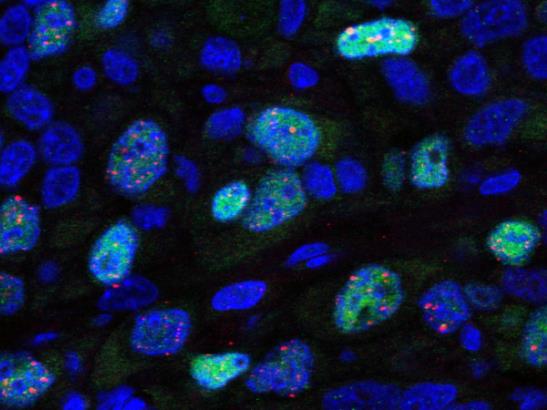
Researchers have determined the structure of a molecular protein complex that helps DNA to be read and its instructions carried out.
The complex, called TFIIIB, is of interest to cancer researchers because the genes it controls are important for cell growth.
It drives the production of some RNAs – cellular messengers that help turn DNA into protein – that are often found at high levels in cancer cells.
A better knowledge of the structure of TFIIIB could allow researchers to design new drugs to precisely target the process of transforming DNA code into proteins – a process called transcription – in cancerous cells.
Potential lines of attack
The study team, including researchers from The Institute of Cancer Research, London, used a technique called X-ray diffraction to study how TFIIIB looked when bound to a short chain of DNA.
In the paper, published in the journal Nature Communications, they identified two regions that have crucial roles in binding the complex together and to the target DNA.
These regions could be potential lines of attack for drugs that target TFIIIB.
The research was funded by a range of organisations including the BBSRC, Cancer Research UK and Wellcome.
Protein essential for promoting tumour growth
TFIIIB is made from three proteins, that bind to DNA near the genes it helps turn into other cell growth proteins.
Once in place, the proteins work with an enzyme called RNA polymerase III to ‘unzip’ the two strands of DNA, ready for the genes to be transcribed.
Of the three proteins, the team was particularly interested to see how one known as Bdp1 is incorporated into the complex. Bdp1 was recently found to be essential in promoting the growth of tumours in some prostate cancers.
They found that one section of Bdp1, called the SANT domain, is the main point of interaction that allows it to bind strongly to both the other proteins and the DNA.
They also identified a separate region called the Bdp1 linker that, if deleted from the protein, reduced the ability of the complex and RNA polymerase III to transcribe genes from DNA.
Research at the ICR is underpinned by generous contributions from our supporters. Find out more about how you can contribute to our mission to make the discoveries to defeat cancer.
Targeted treatment
These two regions could be viable targets for a future drug that aimed to stop the transcription process in cancerous cells – and the structural information gleaned from the study could even help contribute to the drug’s design.
Study leader Dr Alessandro Vannini, Team Leader in Structural Biology at the ICR, said:
“Targeting these sorts of cancer-driving proteins in the cell nucleus is a very challenging task. That’s why we need to obtain structural data on them in their natural context – as part of multi-subunit complexes, such as TFIIIB.
“Pinning down the precise structure of these complexes is vital in finding potential ways to target them with new precision drugs.”
